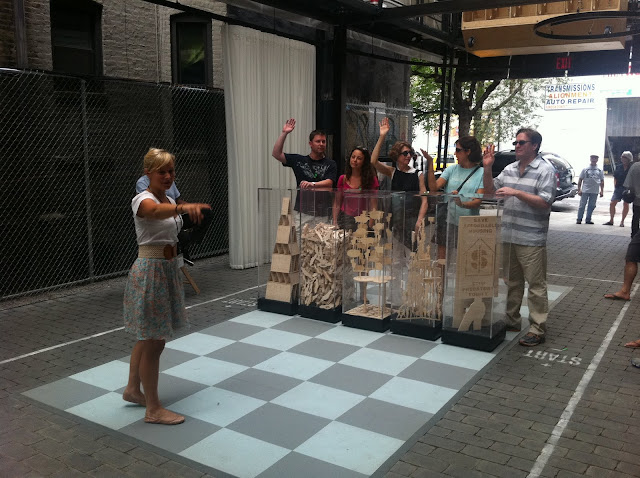LINKS:
- Via the art blog Two Coats of Paint, I learned of this video (below) about Hans Hofmann’s legendary art classes in Provincetown. It contains interviews with many of his former students including Mercedes Matter and Red Grooms, and archival video and photos of his classes.
- If you don't want to spend $75 or $100 or more on a western art history textbook, especially since it won't even have very many good reproductions let alone videos narrated by some of the top people in the field, smARThistory.com's free art history "web-book" is for you.
Dr. Beth Harris and Dr. Steven Zucker, the founders of smARThistory, say they have "aimed for reliable content and a delivery model that is entertaining and occasionally even playful. Our podcasts and screen-casts are spontaneous conversations about works of art where we are not afraid to disagree with each other or art history orthodoxy." I checked out a sampling and agree.
- For some striking large-format photojournalism, check out The Big Picture: New Stories in Photographs, on the Boston Globe’s website.
EXHIBITIONS:
Breaking Ground: The Whitney’s Founding Collection (Until September 18, 2011).
I went to the Whitney mainly to see their comprehensive Lyonel Feininger exhibition so I was surprised to come across this delightful show — a selection from the more than 1000 works of the original Gertrude Vanderbilt Whitney collection. (BTW, even though I’m not a great fan of Feininger, I learned there’s more range and depth to him than I realized.)
 |
| Gertrude Vanderbilt Whitney, Chinoise, 1914. Limestone, 61 1/16 × 19 15/16 × 14 7/8 inches (Whitney Museum of American Art; gift of Gertrude Vanderbilt Whitney 31.79). |
 |
| The original Whitney Museum of American Art at 10 West 8th Street, c. 1931-3. |
One of my favorite paintings in the exhibition is by the under-appreciated painter Louis Eilshemius.
 |
| Louis Eilshemius, The Flying Dutchman, 1908, oil on composition board, 23 1/2 x 25 1/2 inches, (Gift of Gertrude Vanderbilt Whitney). |
Mark di Suvero at Governors Island, presented by Storm King Art Center (until September 25, 2011).
 |
| Governors Island, New York |
so you feel like you’re on summer vacation somewhere. It’s a verdant island with historic old residential homes once used by naval officers. They even have a beach with a volleyball court, a bandstand and a hamburger shack.
 |
| Governors Island Beach |
 |
| Mark di Suvero, Fruit Loops, 2003, Steel, 16’ 4” x 15’ x 11’ 7” (Collection of Agnes Gund, New York). |
Storm King developed a free app to accompany the exhibition. It’s particularly useful since no map is provided and you really need something to locate the sculptures.
BMW Guggenheim Lab, at the corner of Second Avenue and Houston in the Lower East Side (Until October 16, 2011).
This isn’t an exhibition so much as a city-planning science museum. It’s purported goal is to get ideas from people about what makes a city livable, but, so far at least, it’s more didactic than that, and probably more interesting because of it. They will have lectures, films and various events, including games (like the one shown above), about the needs, trade-offs, and challenges of cities.
The "lab" is housed in a temporary space designed by the Japanese architects Atelier Bow-Wow. Made of carbon pillars and carbon fiber and open front and back to the street and air, it's more of a high-tech tent than a building. Practicing what they preach about livable cities, they provide a nice amenity -- a plywood food shack run by Roberta's, Bushwick's popular pizza restaurant.
This will be a long-term experiment. After they finish here, they'll pack up and take the show on the road to Berlin, Mumbai and several other cities.
 |
| Roberta's at the BMW Guggenheim Lab. |
Rembrandt and the Face of Jesus, Philadelphia Museum of Art (Until October 30, 2011).
The show is a bit of a rip-off. The show should be called The Face of Jesus: a few Rembrandt paintings, drawings and prints and a lot of paintings by his pupils. And it costs $16 general admission and an additional $9 for the “Rembrandt” exhibition — $25 total. There are a few major works, though, that for me were worth the price of admission. I particularly liked seeing two of Rembrandt's famous “100 Guilder Prints” side by side so I could observe how Rembrandt wiped the plate in different ways to bring out different features of each print. And there was this profoundly moving painting:
 |
| Rembrandt van Rijn, Christ with Arms Folded, ca. 1657-1661, Oil on canvas, 43 x 35 1/2 inches, (The Hyde Collection, Glens Falls, New York, 1971.37) Photograph by Joseph Lev. |
Okay Van Gogh's Starry Night is famous, but Picasso’s Three Musicians isn't. And Cezanne's Bather and the Brancusi sculptures completely shunned? What's with that?



No comments:
Post a Comment